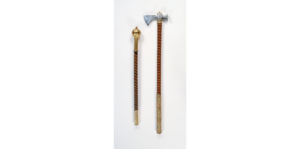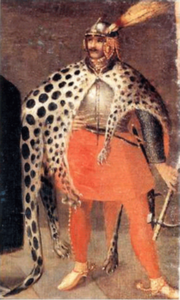War hammers, maces, and battle axes
Hungarian / Polish war hammer



(Source: David Pollock)
Another Hungarian / Polish war hammer:
Let us view a few weapons like these as they were very popular in Hungary and in Europe. The first is a war hammer from Poland or Hungary, from the 17th century: it is displayed in the Wallace collection in England:

Here is a description of the Wallace Museum:
“War Hammer (Czákany), with a square, stepped, hammer-head with a square face and moulded neck, balanced by a long, slightly drooping, fluted beak. Short, socket straps with shaped edges at the top and bottom. Octagonal wooden haft covered with leather and studded with groups of brass-headed nails (probably modern). The haft projects beyond the head at the top and is finished at the top and bottom with a steel cap with a small button in the center.
Polish or Hungarian, the first half of the 17th century.
This type of hammer is called Csákányfocos by J. Szendrei (1896, no. 6681).
J. Kalmár describes a similar hammer as Hungarian, using the name Czakany (Regi Magyar fegyverek, 1971, pp. 34-7, fig. 50). On the other hand, M. Pasziewicz describes A977 as Polish (J.A.A.S., VIII, no. 3, 1975, pp. 225-8, pI. LXXXIV B). A comparable hammer is in the Ashmolean Museum, Oxford (G. M. Wilson in A. MacGregor, 1983, pp. 204-6, no. 92, pI. LXVI). A comparable hammerhead said to have been found locally, is at Dyrham, Gloucestershire. There is a detached head of very similar form in the Henderson Collection, Fitzwilliam Museum, Cambridge.”
The dimensions are:
- War hammer
- Unknown Artist / Maker
- Poland or Hungary
- Date:1st half of 17th century
- Medium: Steel, wood, leather, and copper alloy
- Length:62.2 cm
- Weight:0.64 kg
- Source: https://wallacelive.wallacecollection.org:443/eMP/eMuseumPlus?service=ExternalInterface&module=collection&objectId=61474&viewType=detailView

Hungarian mace (buzogány) and a war ax (fokos), about 1550:

These items are in the Kunsthistorisches Museum Wien, Hofjagd- und Rüstkammer, Austria.

Here is a typical weapon like this:

It is a drawing of a pick ax from the beginning of the 16th century and a Hungarian saber from the same period. The saber was drawn after the picture in the autobiography of Emperor Maximilian I, the so-called «Weiszkunig» where one of the Hungarian envoys was wearing this saber.
Many “fokos” dances have been preserved in Hungarian folklore, here is one of them – imagine that they are practicing (dancing) with battle axes or swords instead of sticks:
https://www.youtube.com/watch?v=m1A7Vr0WxxI

A Hungarian mace (“buzogány”) from 1555
It is made of wood, leather, copper, and gilded silver so it must have been a ceremonial weapon. It was found in Hungary, and presently it is on display in Vienna, in the Kunsthistorisches Museum.
(Source: Hagyomány és Múltidéző)

Perhaps this mace can be compared to the one in the picture:


This weapon may have come from the Ottoman Occupied Lands of Hungary, it is dated between the 16th and the 17th centuries. Jannissaries used very similar axes.
Source: Arms and armour Eastern Europe and the Ottoman Empire
A “fokos” of a Janissary, 17th century

It can be clearly seen that these weapons were widespread in the Ottoman army, as you can see in the picture depicting two Ottoman soldiers from the early 17th century:

Here is another Turkish weapon:

Transylvanian war hammer (“armed hoe”), Museum of Dresden

It is from the end of the 16th century but we have a photo from 1923, taken in Dresden:

It is a pity, that many items were destroyed during WWII and we do not know the exact origin of these weapons. However, we can conclude that they were quite universal and used by all the soldiers…

An Ottoman or Hungarian mace, 17th century
It is difficult to distinguish the Ottoman works from the Hungarian ones because many masters in North Hungary or in Transylvania used very similar designs. This mace is on display in the Topkapi Museum of Istanbul:

Sceptre of Stefan Bocskai (1557-1606), Prince of Transylvania (1605-1606)
The scepter in the collection of the National Museum of Romanian History consists of a spherical head and a handle.

The mace is wrapped in blue enamel and covered with a layer of gilded silver adorned with plant motifs. The metal has been cast in the form of two hemispheres joined by a band bearing two engraved initials, possibly belonging to the craftsman: an ‘H’ and a ‘C’. On top of the mace is a small hemisphere with the base facing downwards. This is also covered in enamel and pierced silver gilt, and is surmounted by a silver gilt arrowhead.

The handle, which was once partly covered in velvet, features a decorative sleeve on its upper, middle, and lower parts, matching the design of the broom with blue enamel and perforated metal leaves. The end of the handle is engraved with the Bocskai family coat of arms in flat relief. In a rectangular shield with a pointed base and surrounded by a dragon with its tail curled around its neck is a lion facing left and holding an upwards-pointing arrow in its right paw. The year ‘1605’ appears above the shield.

Technical details:
Collection: MNIR
Dating: Early modern, early 17th century
Material: Gilded silver, wood, turquoise, enamel
Technique: Hammered, chased, enameled, polished
Dimensions: L = 80 cm; D = 12 cm
This particular piece can be admired in the temporary exhibition “Masterpieces from the MNIR heritage”, open to the visiting public.

A Hungarian mace, 17th century

This mace is in private ownership in Hungary (Fekete Artúr), and it is dated between 1550 and 1650. Its shaft is still the original.

Combined war hammers
These pictures were taken in the Museum of Dresden (by Digladior). Medieval armour is not just about classic swords with a cross-collar. At the Dresden museum, Digladior came across some real curiosities — weapons with unconventional finishes that raise questions and admiration.

Some of these swords have a massive ‘raven beak’ instead of a protective guard — a hammer-like construction that was perhaps intended for attacking weapons or for manipulating an opponent’s weapon. Other pieces have a fork similar to a forward instead of a blade — a tool used to suppress the musket during firing.
Were these weapons used in battle? Or were they used for representation, ceremony, or practice? History is sometimes silent, but the form and function of these swords show that, even in the past, armourers were not afraid to experiment.

Source: http://Digladior
More weapons are coming…
Dear Readers, I can only make this content available through small donations or by selling my books or T-shirts.
If you like my writings, please feel free to support me with a coffee here:
You can check out my books on Amazon or Draft2Digital, they are available in hardcover, paperback, or ebook:
https://www.amazon.com/dp/198020490X
or at https://books2read.com/b/boYd81


My work can also be followed and supported on Patreon: Become a Patron!http://Become a Patron!



